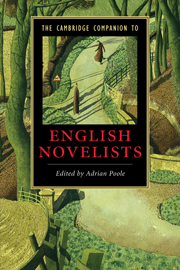Book contents
- Frontmatter
- Introduction
- 1 Daniel Defoe
- 2 Samuel Richardson
- 3 Henry Fielding
- 4 Laurence Sterne
- 5 Frances Burney
- 6 Jane Austen
- 7 Walter Scott
- 8 Charles Dickens
- 9 William Makepeace Thackeray
- 10 Charlotte Brontë
- 11 Emily Brontë
- 12 Elizabeth Gaskell
- 13 Anthony Trollope
- 14 George Eliot
- 15 Thomas Hardy
- 16 Robert Louis Stevenson
- 17 Henry James
- 18 Joseph Conrad
- 19 D. H. Lawrence
- 20 James Joyce
- 21 E. M. Forster
- 22 Virginia Woolf
- 23 Elizabeth Bowen
- 24 Henry Green
- 25 Evelyn Waugh
- 26 Graham Greene
- 27 William Golding
- Guide to further reading
- Index
22 - Virginia Woolf
Published online by Cambridge University Press: 28 March 2010
- Frontmatter
- Introduction
- 1 Daniel Defoe
- 2 Samuel Richardson
- 3 Henry Fielding
- 4 Laurence Sterne
- 5 Frances Burney
- 6 Jane Austen
- 7 Walter Scott
- 8 Charles Dickens
- 9 William Makepeace Thackeray
- 10 Charlotte Brontë
- 11 Emily Brontë
- 12 Elizabeth Gaskell
- 13 Anthony Trollope
- 14 George Eliot
- 15 Thomas Hardy
- 16 Robert Louis Stevenson
- 17 Henry James
- 18 Joseph Conrad
- 19 D. H. Lawrence
- 20 James Joyce
- 21 E. M. Forster
- 22 Virginia Woolf
- 23 Elizabeth Bowen
- 24 Henry Green
- 25 Evelyn Waugh
- 26 Graham Greene
- 27 William Golding
- Guide to further reading
- Index
Summary
Even before she was enshrined among the most important women writers of the twentieth century, Virginia Woolf fretted that such might be her fate. 'One does not want', she insisted in a diary entry from 1921, 'an established reputation, such as I think I was getting, as one of our leading female novelists.' Be that as it may, that is the reputation she possessed then and still enjoys, although on different and ever shifting grounds, today. At the time she voiced this worry, her reputation was based on two novels, the adventurous but ultimately abortive female Bildungsroman, The Voyage Out (1915), the more conventional, but socially shrewder Night and Day (1919), and a volume of experimental short fiction, Kew Gardens (1919). The revolutionary modernist works - Mrs Dalloway (1925), To the Lighthouse (1927), Orlando (1928), The Waves (1931), The Years (1937), and Between the Acts (1941) - were yet to be written. Nor could their innovative forms have been predicted of the writer whose protests against the 'masculinist' conception and domination of life were more ideological than artistic. The Voyage Outand Night and Day were eloquent in denouncing the hypocrisies and inequities that buttressed patriarchy, but their feminism was not yet allied to a revolutionary programme for the novel. Her apprentice works did little to confute the assumption widely held then - and arguably still prevalent today - that women novelists, whether conservative or radical in their conception of society and women's role and destiny within it, are unlikely to join in the more aggressive assaults on tradition spearheaded by the combative male modernists of the day.
- Type
- Chapter
- Information
- The Cambridge Companion to English Novelists , pp. 361 - 376Publisher: Cambridge University PressPrint publication year: 2009
- 2
- Cited by

